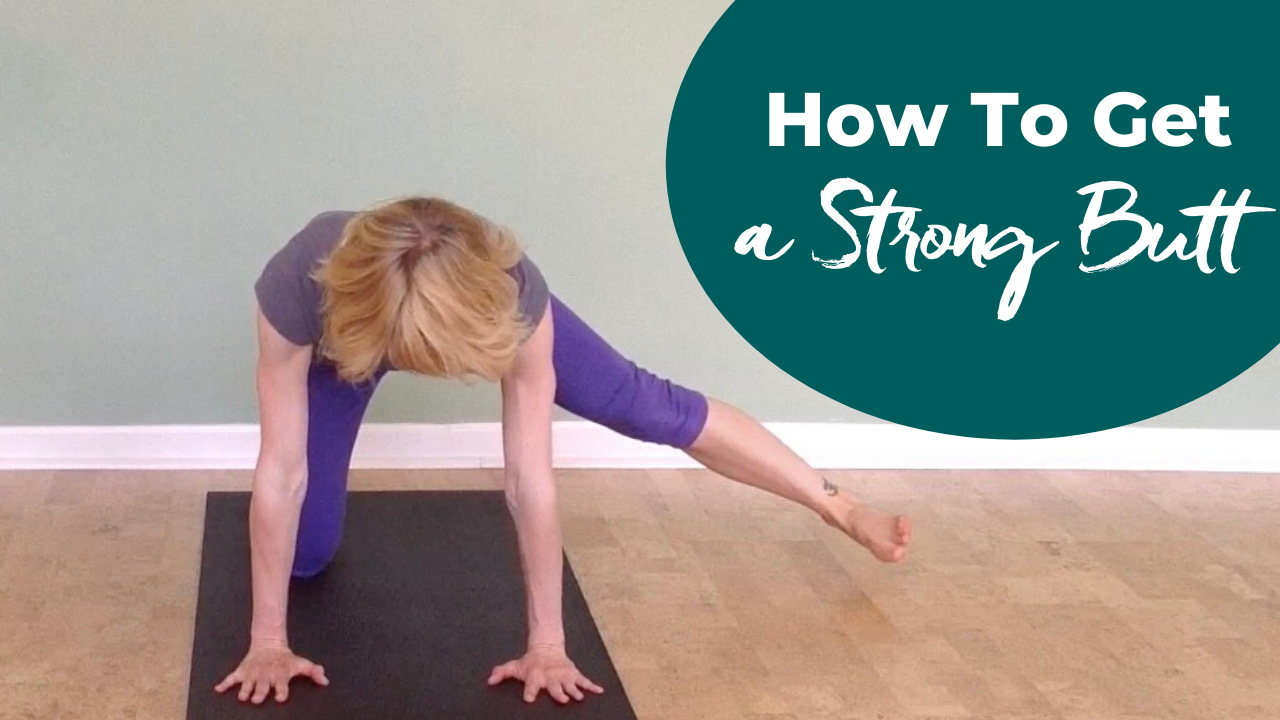How to Get a Strong Butt
Aug 26, 2020
This post is from the archives, but this exercise remains a favorite of mine for glute strength. A strong butt is not just pretty, it’s crucial for good healthy movement.
Your butt muscle (gluteus maximus) is attached to your pelvis, which is attached to your spine, which is attached to your neck and shoulders, etc. And on the other end, your glut max is attached to your thigh bone, which is part of the knee, which is attached to your foot. So pretty much any body part can be suffering from a weak butt.
This fabulous exercise will target your rear while strengthening your arms, shoulders, and core. In the video, I will show you the proper form as well as explain the function of this extremely effective exercise. You’ll see two different variations of the exercise. They both focus on the same muscles with small changes to the movement.
Quadruped with Hip Abduction in External Rotation
- Come onto hands and knees.
- Line up your wrists directly under your shoulders with your arms parallel to each other.
- Align your knees behind your wrists.
- If your knees are uncomfortable on the ground, soften the surface with a blanket or pillow.
- If your wrists are uncomfortable in the starting position, place your forearms on a chair or stool with the appropriate height, so your shoulders are as high as your hips and your spine is parallel to the ceiling. Palms are either flat on the seat of the chair or make fists and turn the palms inward. Like here:

Step 1
- Now that you're set up comfortably, reach one leg out to the side, like a kickstand.
- Lift your foot off the ground for a couple of seconds before lowering it down.
- You should feel your butt muscles on both sides working. You might additionally notice your arms and core due to the stabilization of the whole body during movement.
Step 2
- Reach one leg straight back behind you, like a runner in the starting block.
- Now, lift your leg only a few inches off the floor (it's more of a hover).
- Now externally rotate your leg so your toes are facing forward.
- Swing your leg forward with control. It sort of describes a quarter of a circle.
Cueing
- Maintain your control throughout the movement and don’t rush through anything.
- Breathe out during the difficult part of the exercise.
- Watch for any swaying or leaning to the opposite side. A good indicator of this is to notice which arm is working harder. If the contralateral (opposite) arm is working harder, then you’re doing it correctly. If the opposite arm is bending, then you are leaning away from the leg. It's called counterbalancing and it's your body's way to avoid having to work hard. Remember to keep your torso squared off with the floor, and both arms are completely straight. If necessary, pause and reposition your body back into alignment before continuing with your repetitions.
- If you can’t stop leaning, then you might be lifting the leg too high. Your hip joint might be tight or the muscles weak. Keep the leg very close to the ground, almost touching (Remember that hover I was talking about?)
You'll feel your butt muscles work harder with the leg lower!
Related: The Cueing Cure: Dramatically Improve Your Verbal Cueing in 30-Days
Isn't that weird? Shouldn't it be the opposite? That's what most people think. Our society is so trained to search for more. We think, "If I want stronger muscles, then I need to do more repetitions or I need to lift more weight, I need to do the harder, more difficult variations."
It's just not true. If you do harder exercises then you train the muscles that are already strong more. But you don't train the muscles that are not strong yet. They don't have a chance, they simply can't keep up.
It's not the exercise, it's the technique that gives you the results.
The only way to get to the weak muscles is to do simpler and easier exercises. Do those well. Pay a lot of attention to the details of the exercise. Put your mind into it. Find the ways how your body cheats (for instance by counterbalancing).
What can I say? That's Pilates for you. Paradox rox!
My other go-to butt strengthening exercises without equipment are Clams, Bent Knee Opening, Hip Extension with a thera band, Grasshopper, Standing Scooter, and of course the Side Kick Series. I've filmed and described all of these in detail with tons of cues and common mistakes. They are available inside the Pilates Encyclopedia membership.
Related: How to Make The Glutes Work in Side Kick Series
Related: How to Keep the Work in Your Glutes in Parakeet on the Trapeze Table










